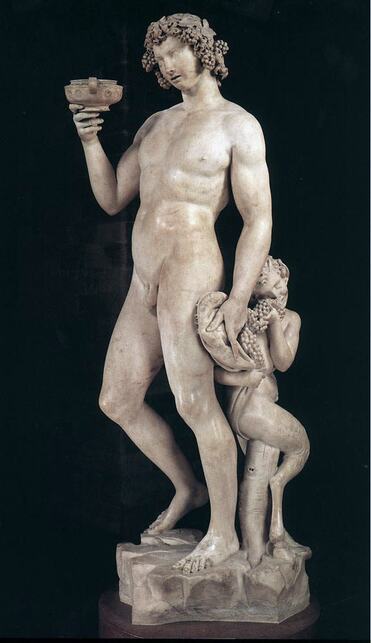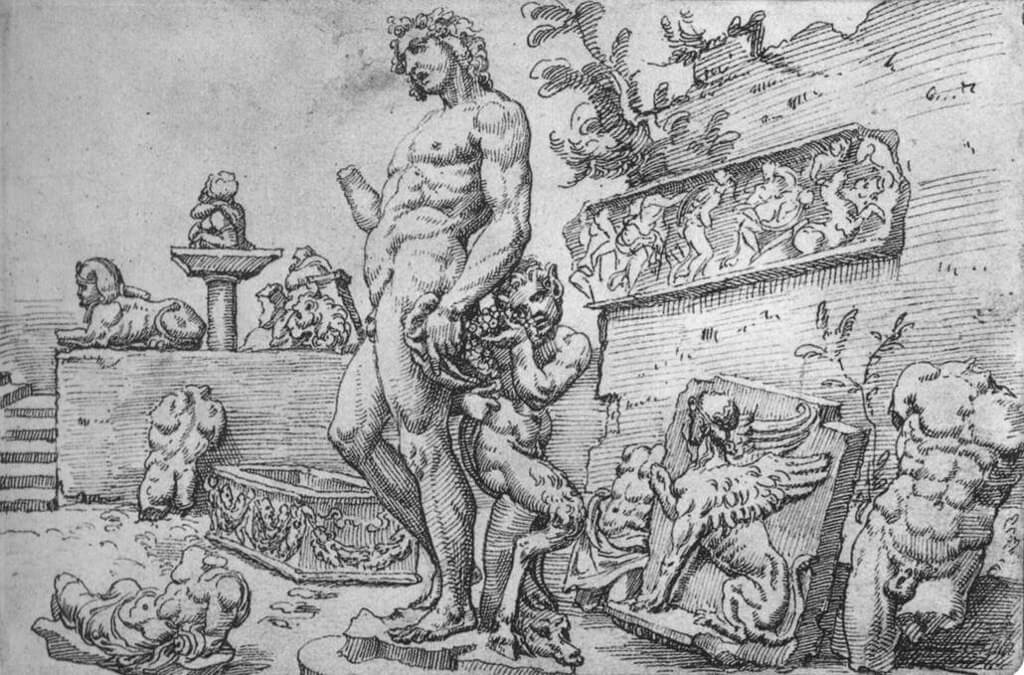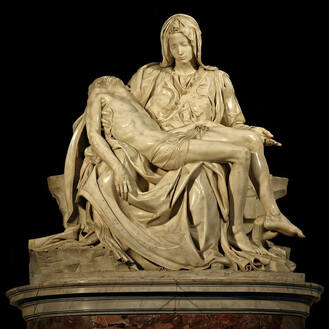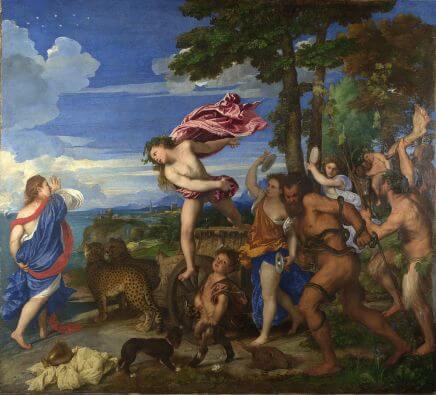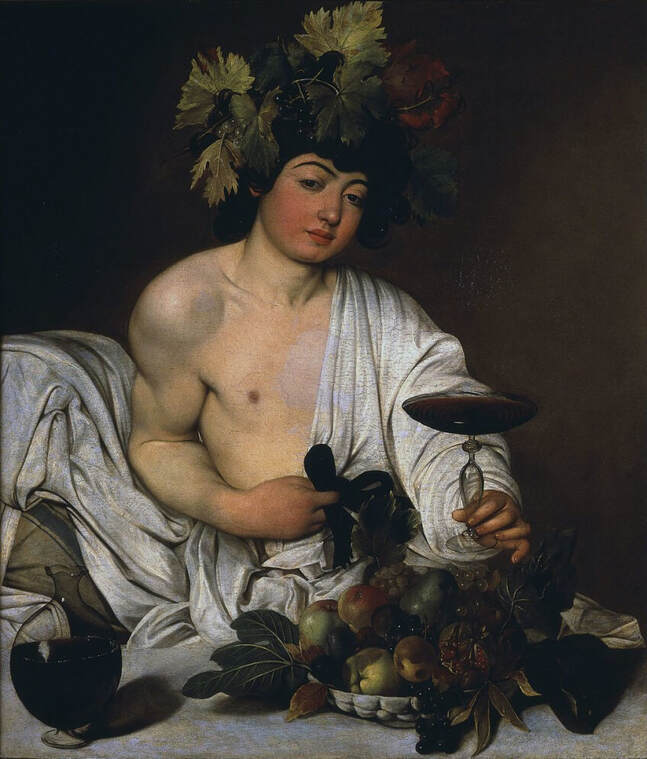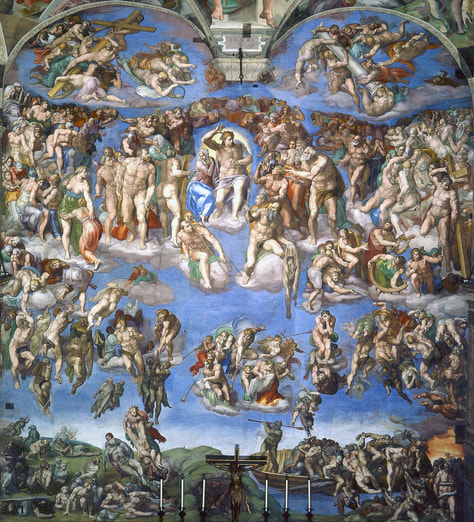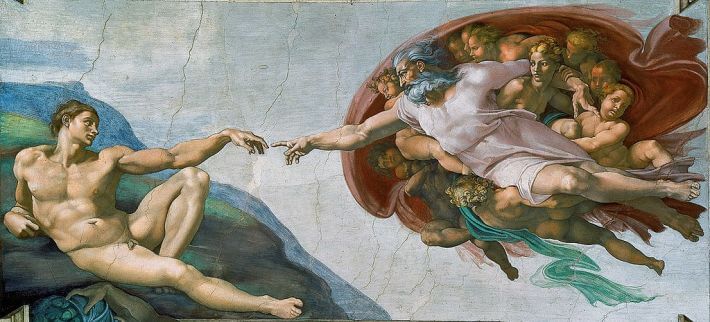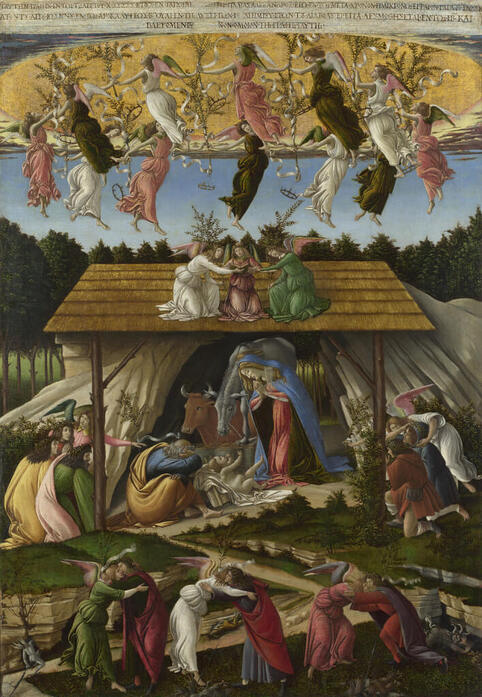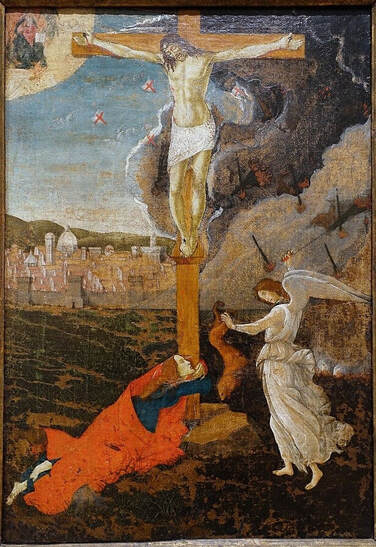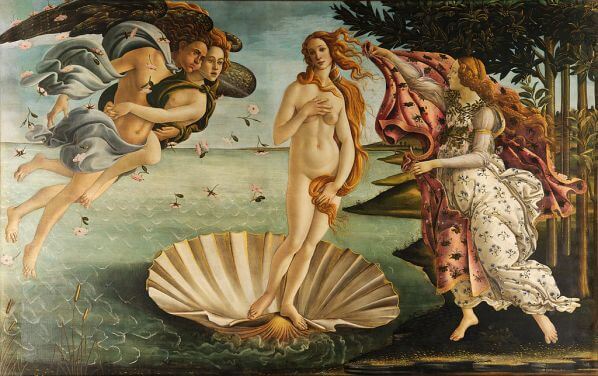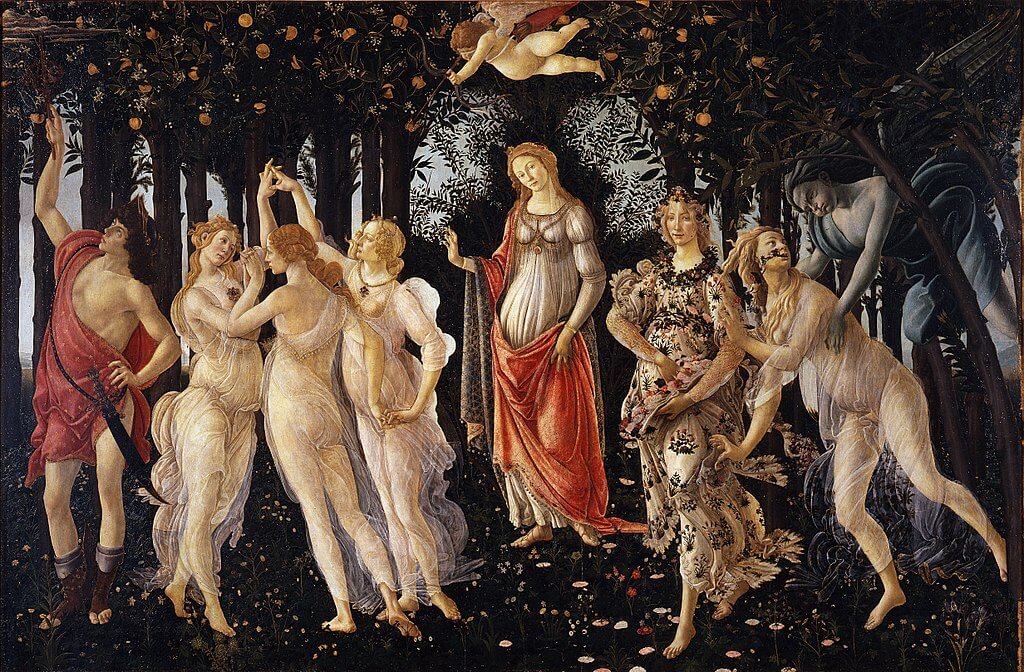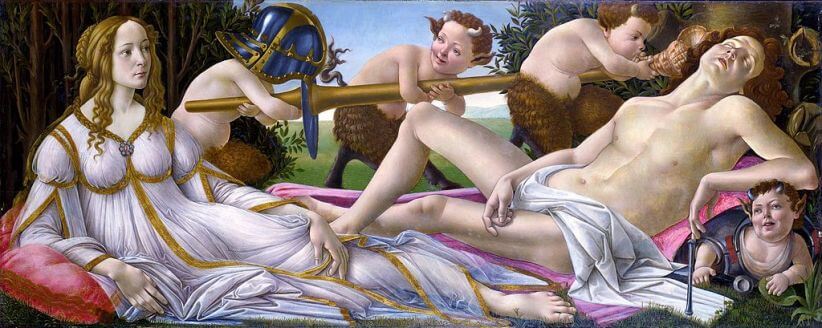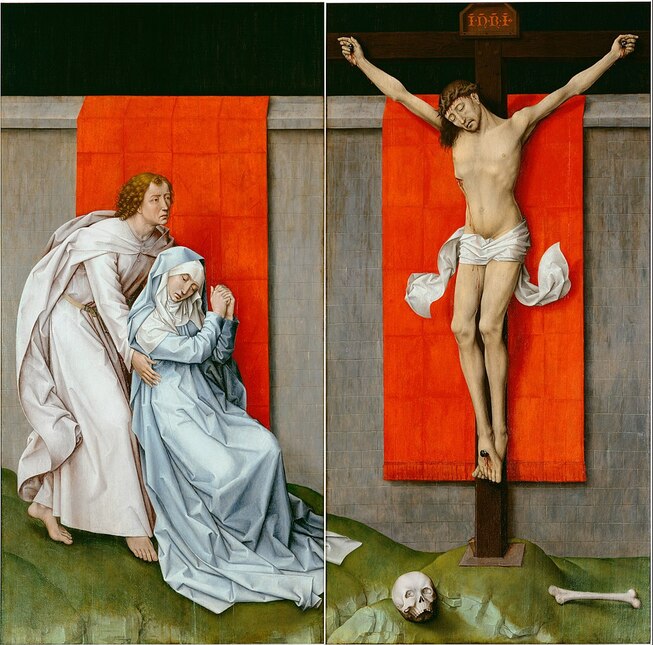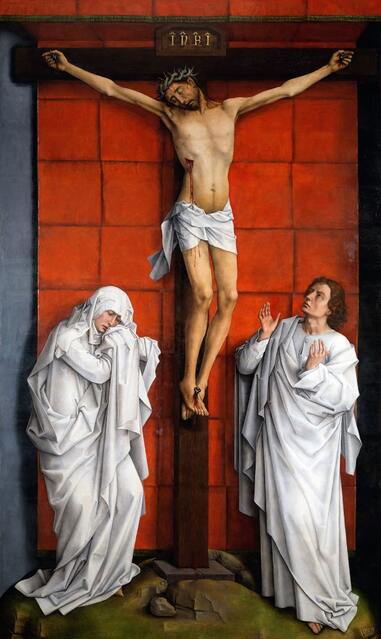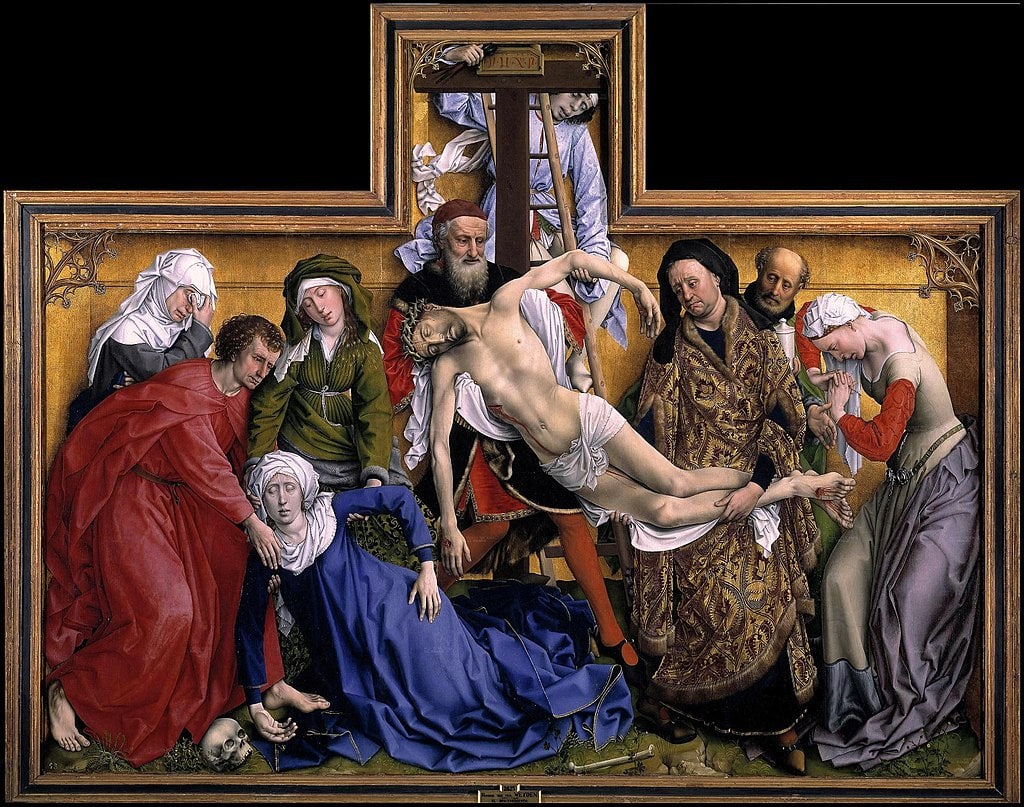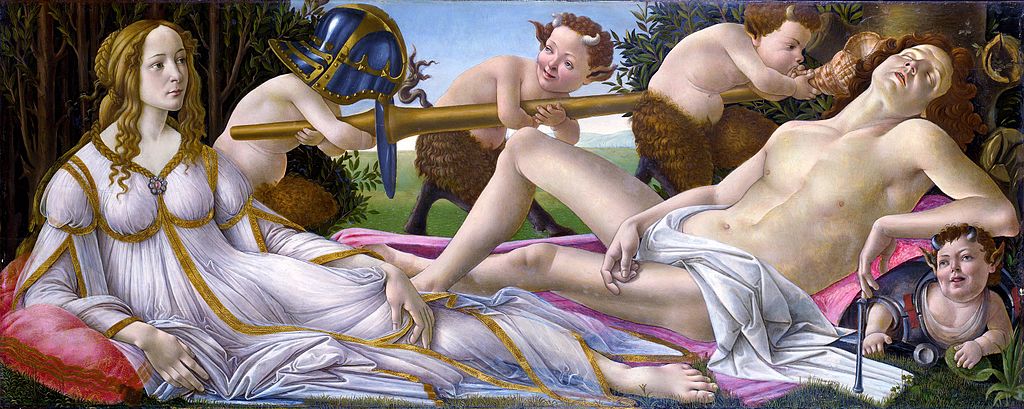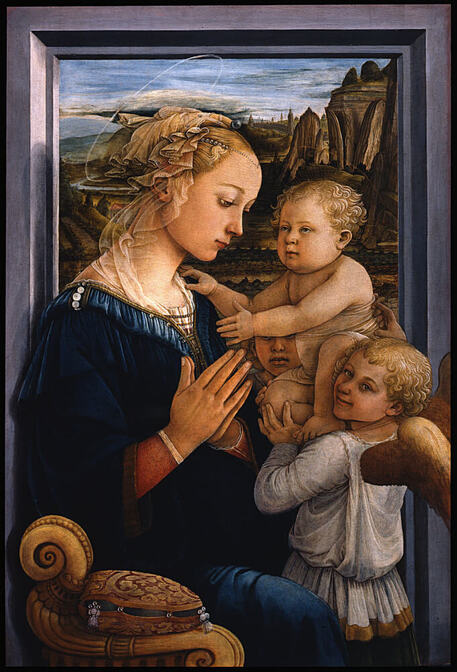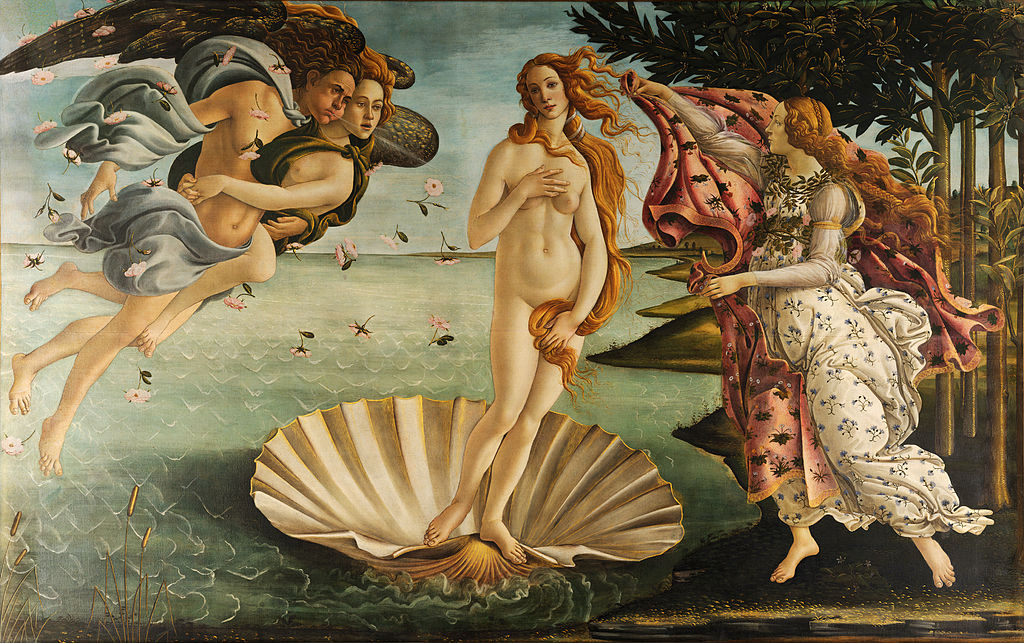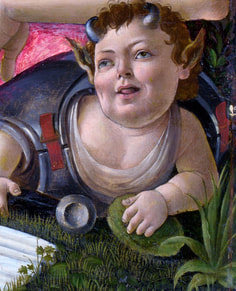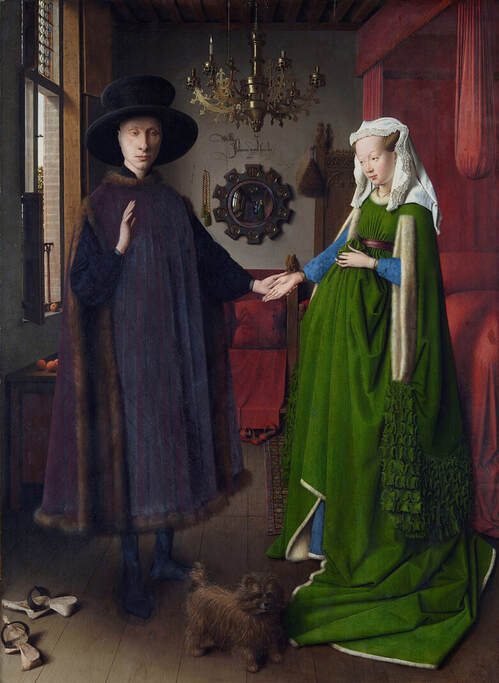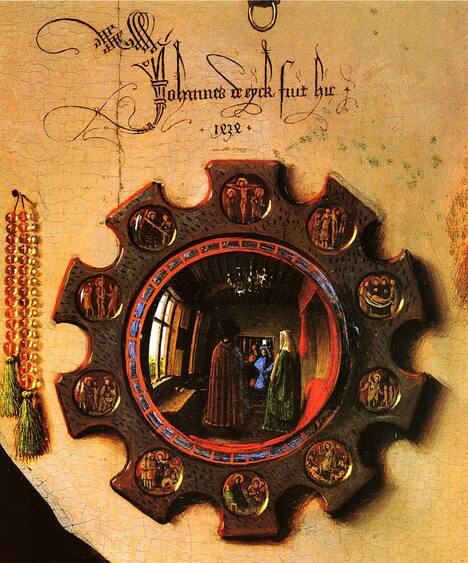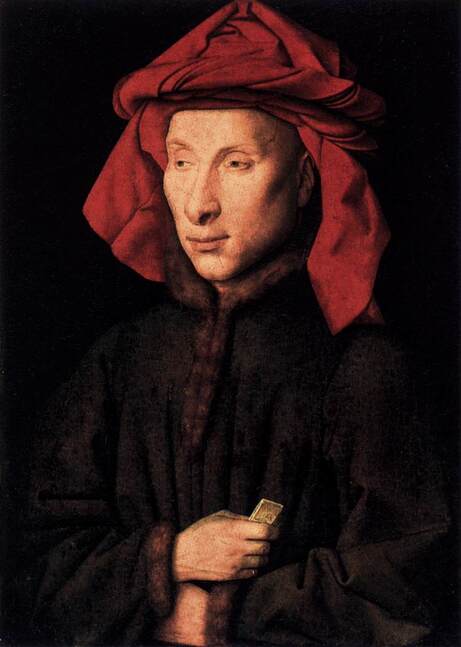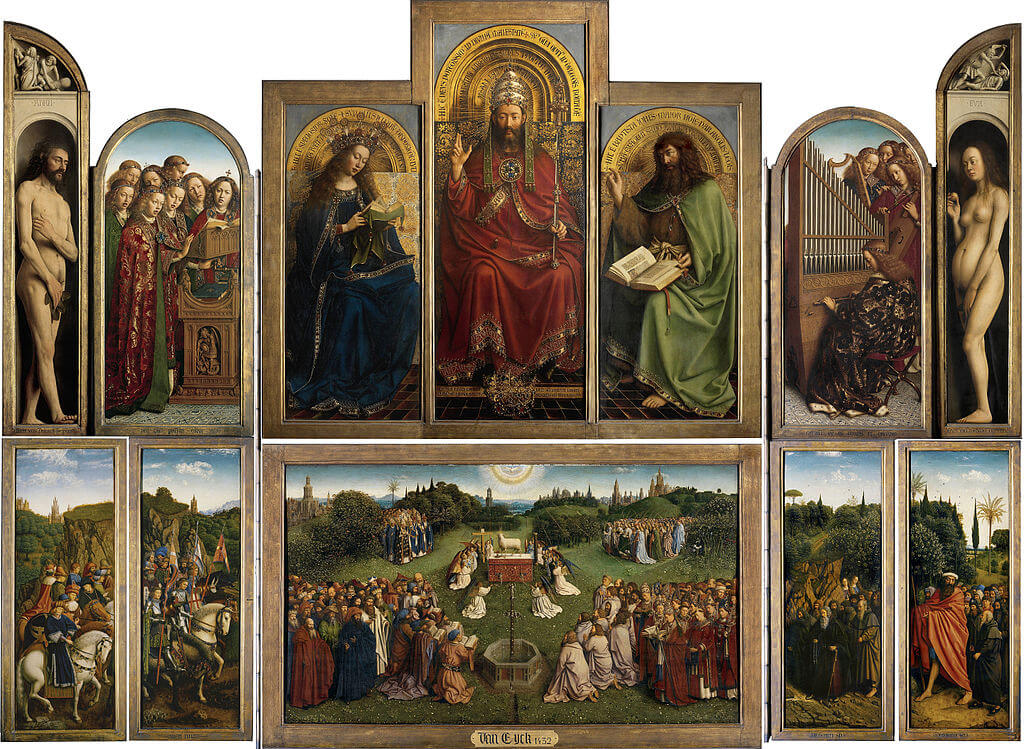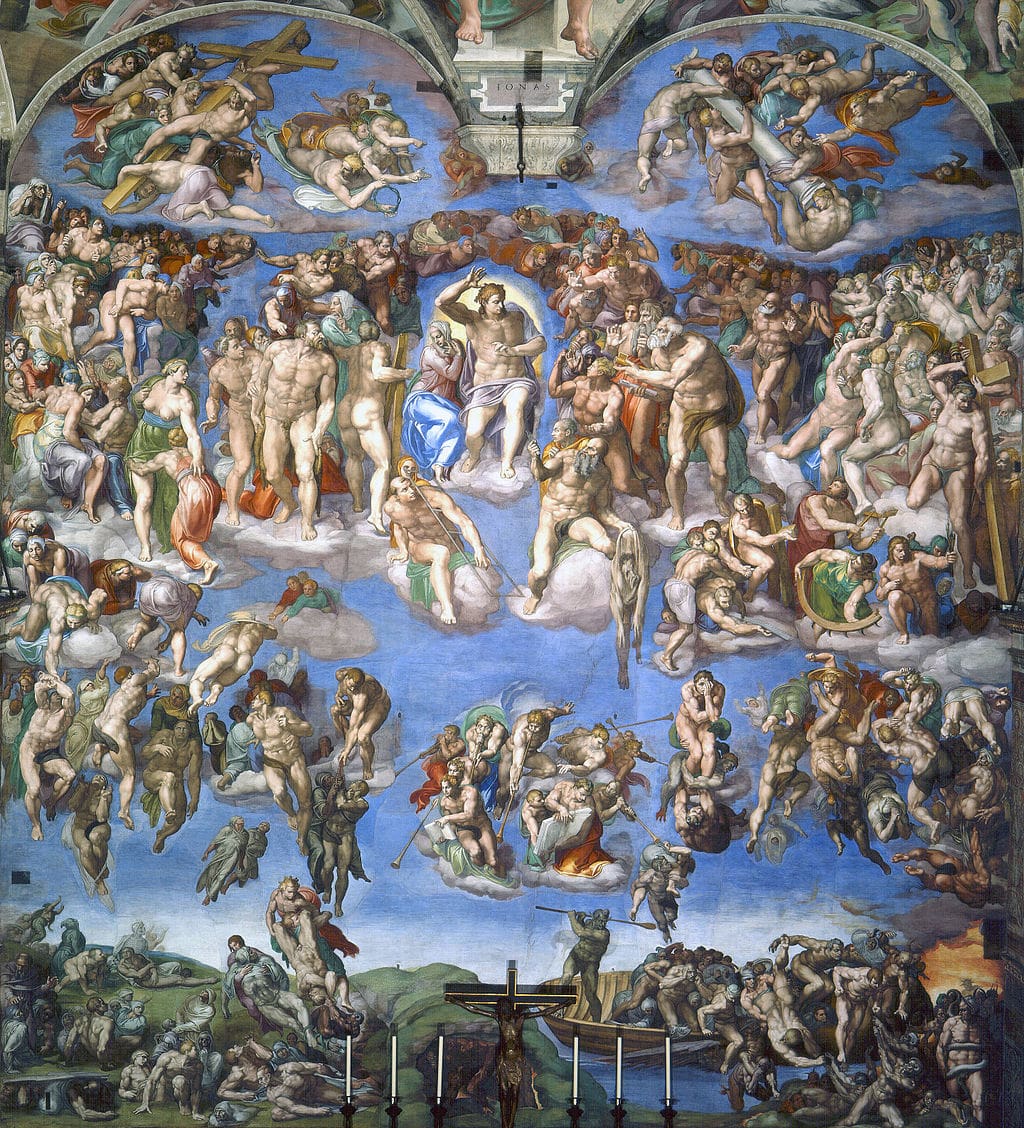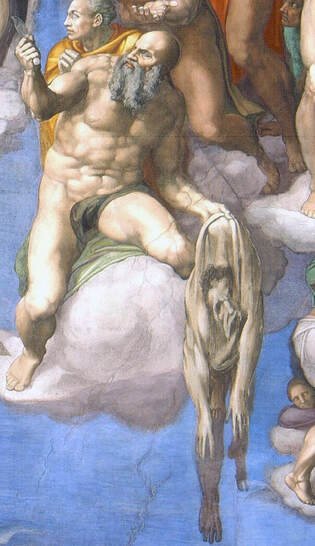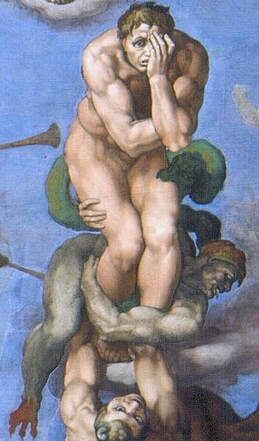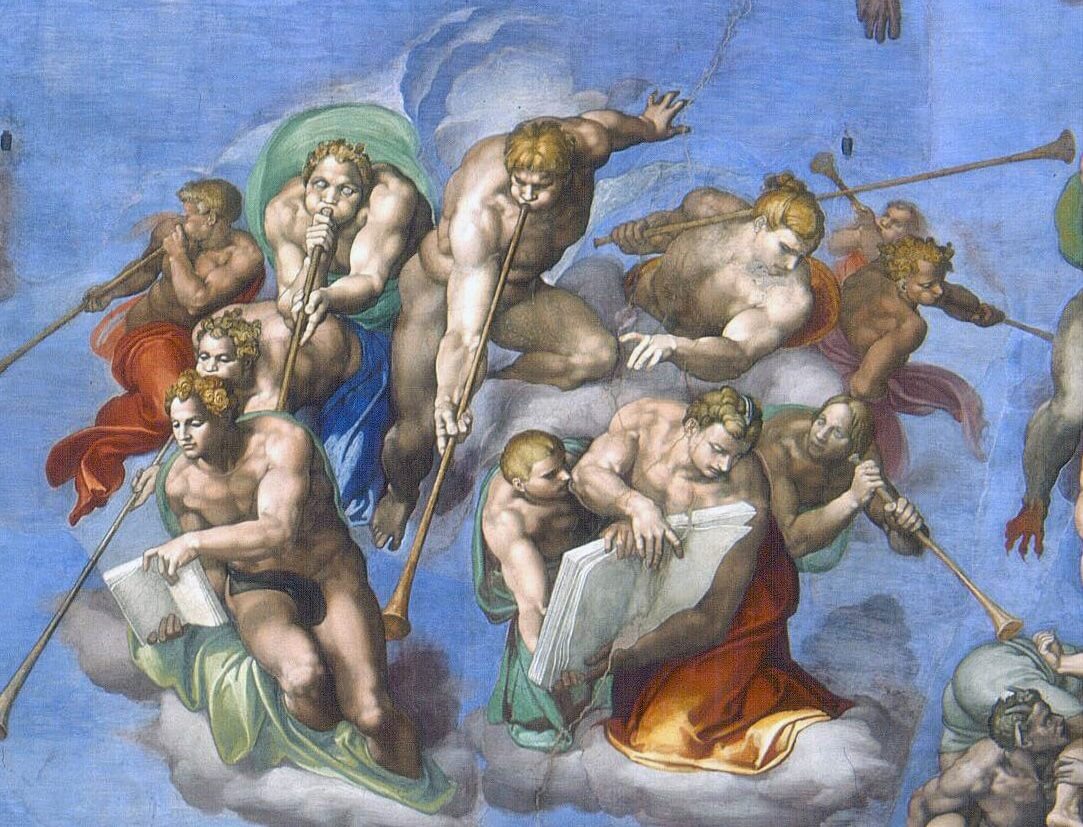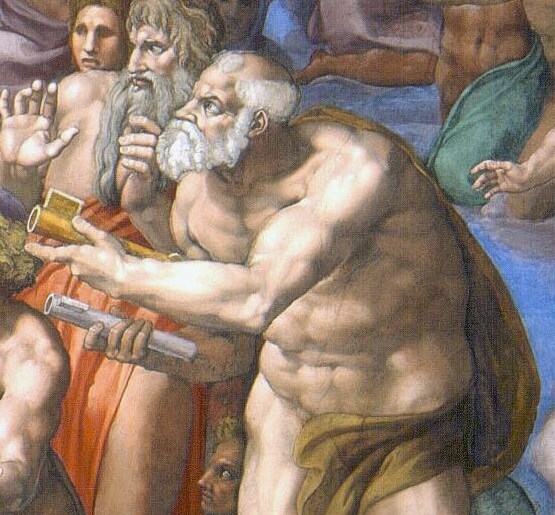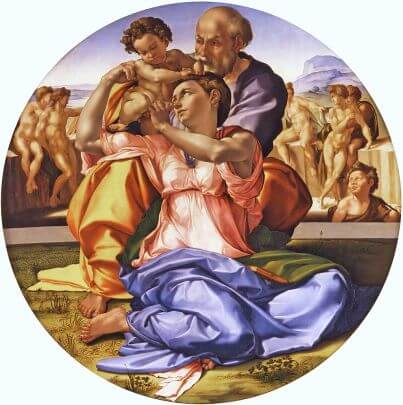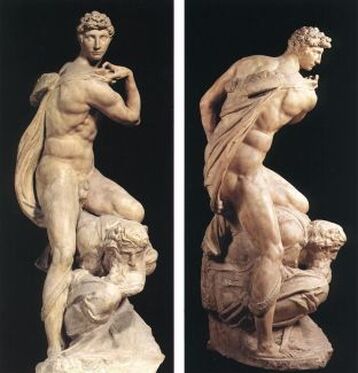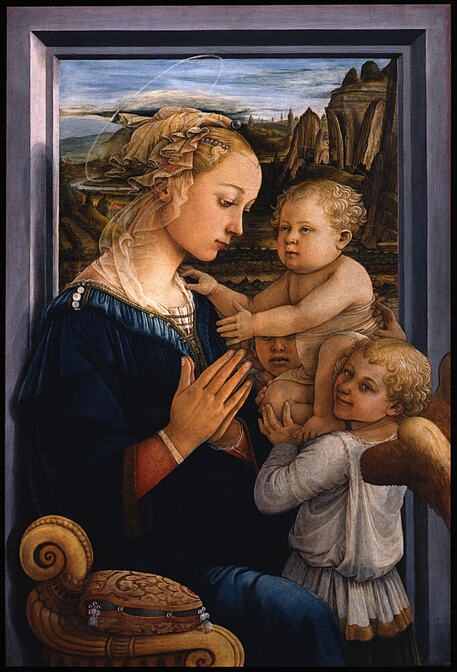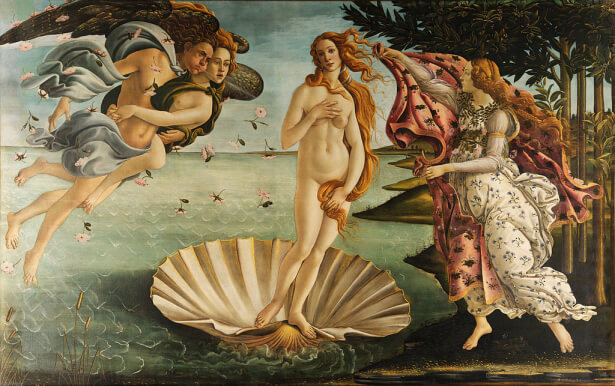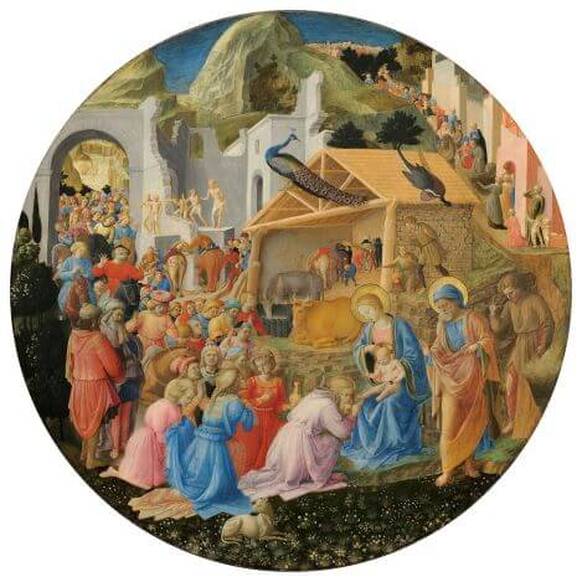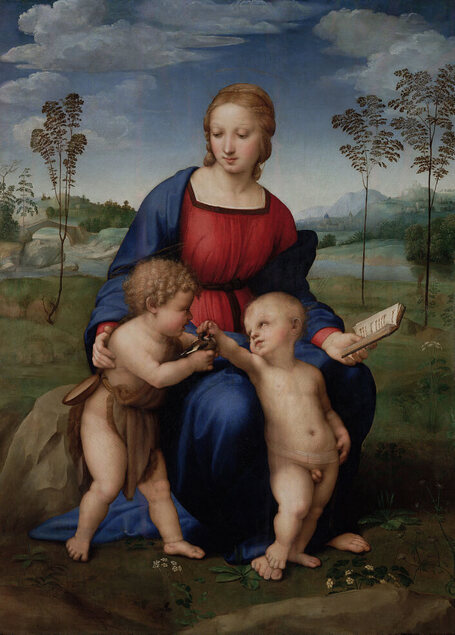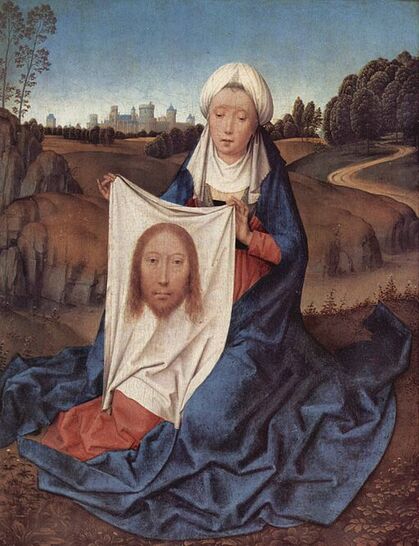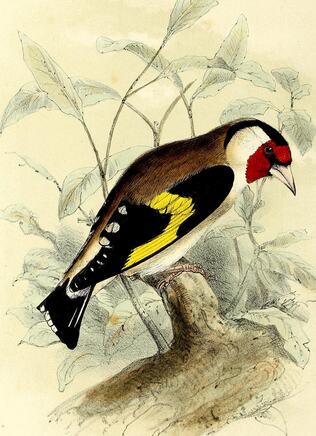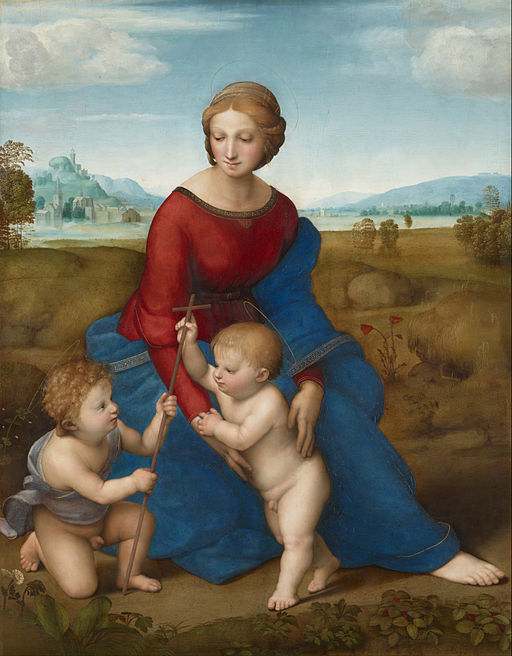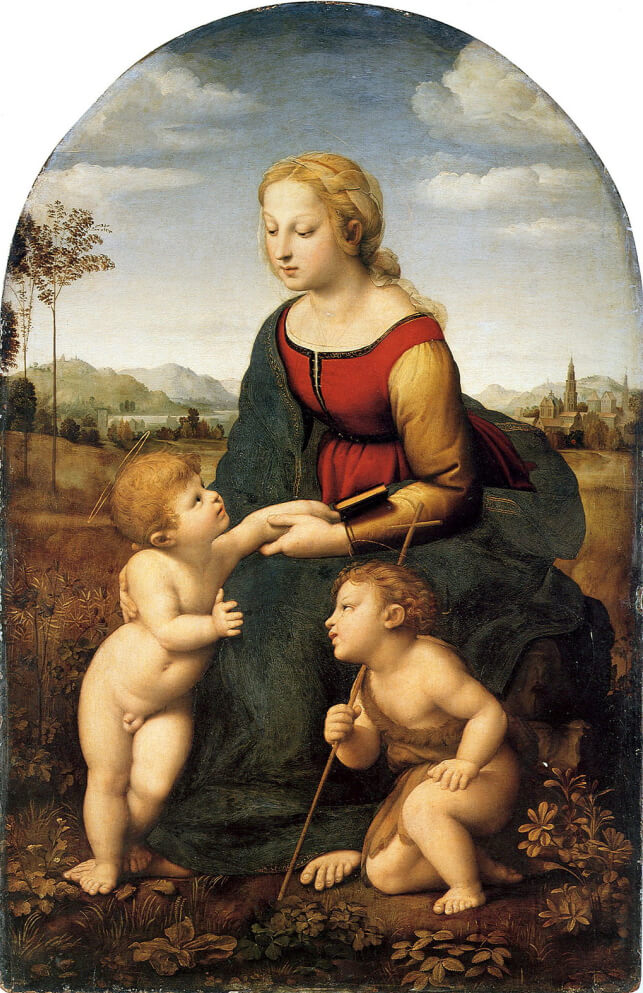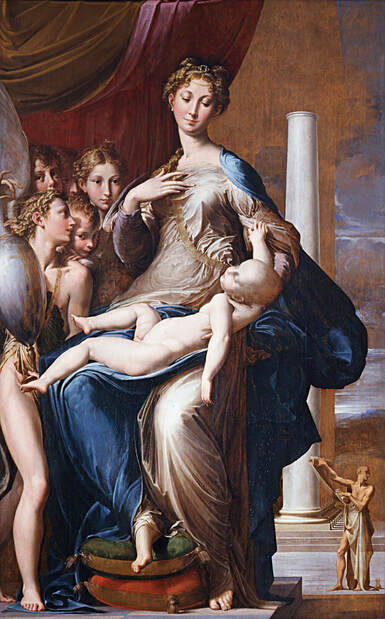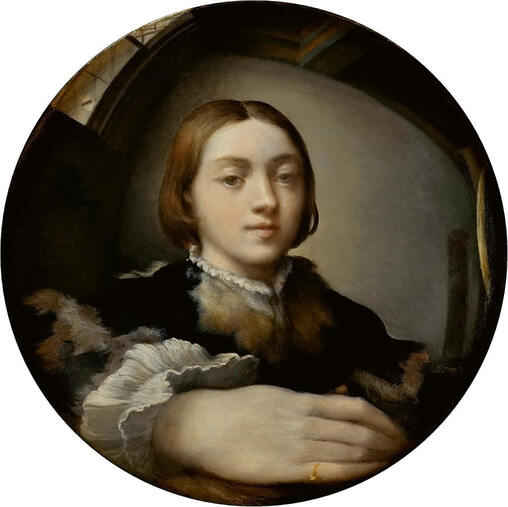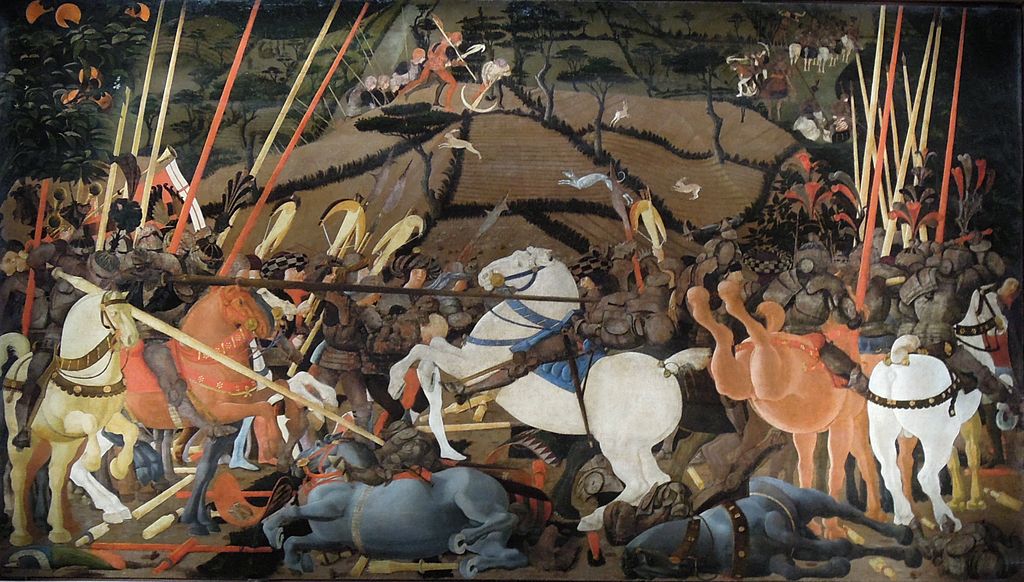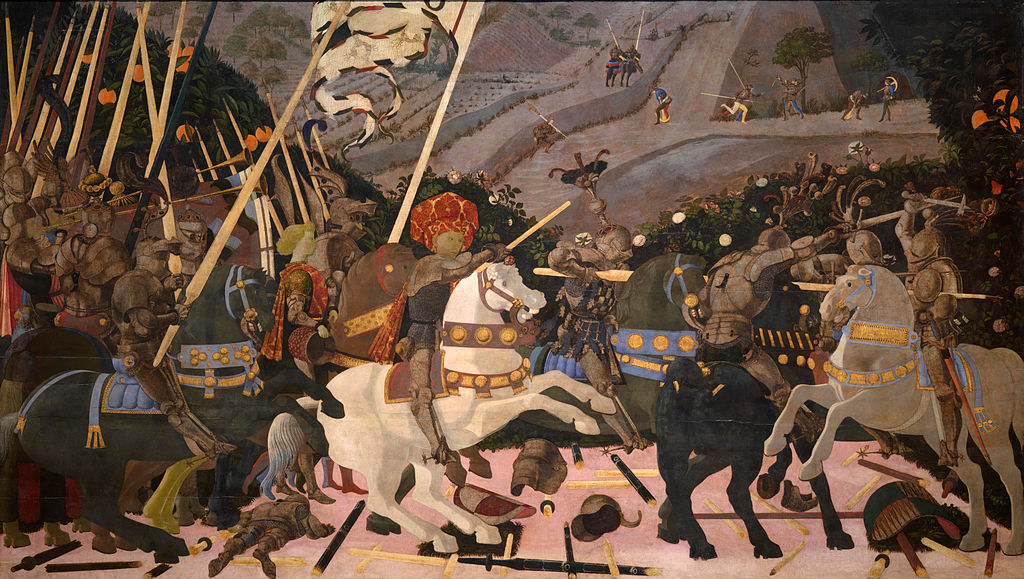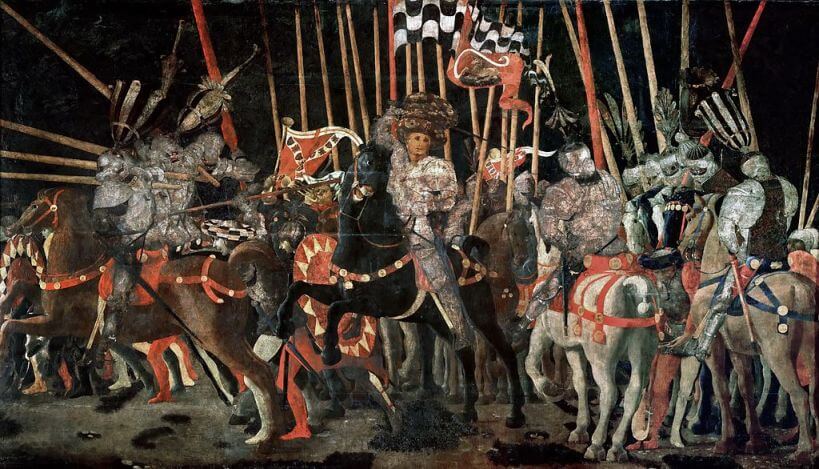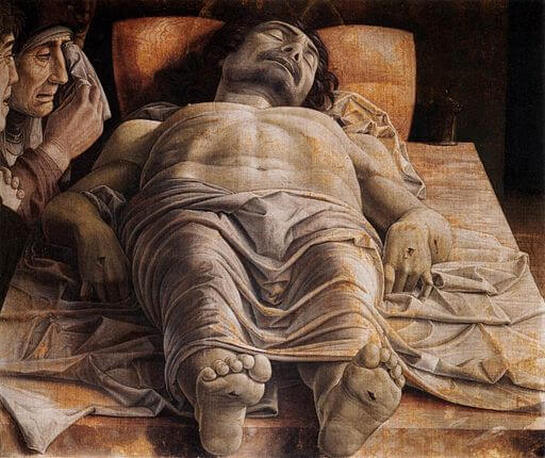|
Where? Room 3 on the ground floor of the Bargello Museum
When? 1496-1497 Commissioned by? Raffaele Riario, a cardinal and art collector. What do you see? A life-like statue of the Roman god Bacchus. He is naked and standing with a large cup of wine in his right hand. He has curly hair made up of grapes and a wreath of ivy leaves in his hair. The effects of drinking the wine are visible in the expression of his face and his unstable pose. Bacchus seems to be looking at the cup, but his eyes are rolling. His unstable pose can be seen best from the right side as illustrated in the drawing of Maarten van Heemskerck of this statue in the garden of its owner Jacopo Galli. Bacchus is leaning somewhat backward with his shoulders pulled back and his belly pointing forward. Interestingly, when we look from the left side, the body seems to be quite balanced. So, when walking around this statue, he sometimes seems to be out of balance and from other angles he seems quite stable. In his left hand, Bacchus is holding a large bunch of grapes and a piece of animal skin that touches the rock-like base. You can see the face of the animal from the back of the statue and some have suggested that this is a wolf, though there are several other opinions on what animal it is. Behind his left leg is a tree trunk for the stability of the sculpture. Next to Bacchus is a young satyr, which is a male figure with a permanent erection and with the ears, horns, legs, and tail of a goat. The satyr is smiling an eating from the grapes.
Backstory: Michelangelo started to work on this painting in July 1596 when he was 21 years old. Cardinal Raffaele Riario commissioned the statue. He had earlier bought a statue from Michelangelo, called Sleeping Cupid. But after he bought it, he discovered that the statue was not an antique one as was told to him, but rather a statue created by Michelangelo (the statue is now lost). Nevertheless, Riario’s interest in Michelangelo’s talents was triggered, and he commissioned him to make a statue of Bacchus.
Who is Bacchus? Bacchus is the Roman god of wine, intoxication, fertility, religious ecstasy, and drama. His equivalent in Greek mythology is Dyonisus. He is the son of Zeus, and there are different stories about who his mother is, but the most popular one is that his mother was Semele who was a mortal. Bacchus is often depicted with grapes, ivy leaves, wine, and satyrs (like in this sculpture).
Bacchus has been a source of inspiration for many artists in ancient Greece and during the Renaissance. For example, Titian made a painting on Bacchus and Ariadne which is in the National Gallery in London. Caravaggio also created a famous painting of Bacchus which is in the Uffizi Museum in Florence.
Fun fact: The penis of Bacchus is missing. It seems to have been removed by a chisel rather than broken off. Also, the erection of the satyr, which was typical for him, is not present. Moreover, a hand of the statue had broken off (see the drawing of Van Heemskerck above) but was restored before 1553. It is unknown who removed some of these parts, but some people suggest that it could have been Michelangelo himself to make the statue look more like one from ancient Greece (where some of those body parts were often missing).
Michelangelo’s intention with this statue was indeed to create it in the style of the Greek antique statues, and he succeeded in this as this statue was regularly mistaken to be a statue from ancient Greece. Michelangelo wanted the statue to be in this ancient style to prove that at 21 years old he would already rival the famous ancient Greek sculptors. In that way, he could establish his reputation quickly. Interested in a copy for yourself? Framed poster of statue (Amazon links).
3 Comments
Where? Room 57 of the National Gallery
When? 1500 Commissioned by? Botticelli probably made this picture for himself What do you see? In the center of this painting, you can see a naked baby Jesus. His mother, the Virgin Mary, is depicted to his right and is much larger than the other figures. His father, Saint Joseph, is on his left. Behind Jesus are a horse and an ox. Together they are staying in a stable. On top of the stable are three angels. One is reading a book, and the other two are holding an olive branch. To the left of Joseph is an angel in pink, holding an olive branch with a scroll attached to it, while reaching out to Joseph to introduce the three wise men. On the right of Mary is another angel with three shepherds who want to pay their respects to Jesus. In the foreground are three pairs consisting of one angel and one man embracing each other. Each pair holds an olive branch in their hand with a scroll attached to it. They are surrounded by several little imps or devils who are killing themselves with their spears. On top of the painting is a choir of 12 angels holding hands. The angels are doing a mystic ring dance. They are also holding an olive branch in their hands with a scroll attached to it and a crown hanging at the bottom of the branch. The angels are under the golden dome of heaven. Above this dome is a Greek inscription based on some parts of the Revelations of John related to the apocalypse. Backstory: This painting is also called ‘The Mystical Nativity’, and it is the only painting that Botticelli signed. This painting combines the story of the birth of Jesus with his return to earth according to the apocalypse. The title of this painting contains the word mystic because the parts of the painting referring to the apocalypse are prophetic and express a mystery. The word mystic is occasionally used to refer to exceptional paintings with mysterious and symbolic content. Another example of such a painting is the Mystic Crucifixion by Botticelli which is in the Fogg Art Museum in Boston.
Inscription: The inscription on top of the painting contains a message in Greek. It is translated as: “I Sandro painted this picture at the end of the year 1500 in the troubles in Italy in the half time after the time according to the 11th chapter of St. John in the second woe of the Apocalypse in the loosing of the devil for three and a half years. Then he will be chained in the 12th chapter and we shall see him trodden down as in this picture.” This message of Botticelli is based on the 11th and 12th chapter of the Revelations of John.
Botticelli believed that the apocalypse as described in the Bible was going to happen in 1504. Specifically, he believed that he was living in the Tribulation, a short period of time in which the world would suffer from hardship and disasters. He believed that the Millennium, a period of a thousand years during which Jesus would return to earth, would start in three and a half years. This belief of Botticelli was particularly based on the various wars going on at that time and the hanging, two years earlier, of the Florentine preacher Savonarola of whom Botticelli was a follower. Symbolism:
Who is Botticelli? Sandro Botticelli (1445-1510) was born as Alessandro di Mariano di Vanni Filipepi in Florence. Most of his paintings have a religious theme, but he also painted portraits and mythological scenes. The latter theme resulted in his most famous works, such as The Birth of Venus and La Primavera, both in the Uffizi Museum. His painting of Venus and Mars, which is also in the National Gallery, is also a masterpiece. In the 1490s, Botticelli got heavily influenced by the extremist preacher Savonarola, and he even stopped painting for a while to become a full member of Savonarola’s sect. However, he picked up painting again after a while, though his productivity was lower than before (though this is not entirely certain as almost all paintings of Botticelli are undated).
Fun fact: The Nativity scene in this painting is the story of the birth of Jesus as described in the gospels of Matthew and Luke. Mary was still a virgin, and God promised her that she would give birth to the Christ. The accounts of Matthew and Luke, however, differ quite a bit and both have their unique components.
According to Matthew, Jesus was visited by three wise men who followed a star to worship him. Luke describes that an angel announces the birth of Jesus to the shepherds and that they subsequently visit Jesus. Also, according to Luke, but not according to Matthew, the birth of Jesus happened in Bethlehem and Jesus was born in a stable. Botticelli combined elements from both gospels for this painting. Interested in a copy for yourself? Poster of canvas. The Crucifixion, with the Virgin and Saint John the Evangelist Mourning by Rogier van der Weyden2/26/2020
Where? Gallery 306 of the Philadelphia Museum of Art
When? About 1460 Commissioned by? Unknown What do you see?
Symbolism: The skull and the bone refer to Golgotha which means ‘place of the skull’ and was the hill where the crucifixion of Jesus took place. The vermillion banners refer to the blood of Jesus. The dark sky refers to the three hours of darkness during the crucifixion. This darkness is described in Matthew 27:45, Mark 15:33, and Luke 23:44. After the darkness ended, Jesus died. Interestingly, John the Evangelist, probably the writer of the Gospel of John, is the only gospel writer who does not refer to this darkness during the crucifixion.
Who is Van der Weyden? Rogier van der Weyden, also known as Roger de la Pasture, was born in 1399/1400 in Tournai, Belgium. When he was about 36 years old, he moved to Brussels, where he probably lived until he died in 1464. Many of his surviving works are altarpieces, triptychs, diptychs, or portraits. He was a popular painter during his lifetime and received many international commissions for his work, which was rare for that time. Together with Robert Campin and Jan van Eyck, Van der Weyden is considered to be the most influential 15th-century painter from the Northern part of Europe. Van der Weyden was an innovative painter. He was one of the first to include commissioners of his work as participants in the religious scenes that he painted. He also stood out from other painters by including the emotions of his subjects into the painting. One of his masterpieces is The Descent of the Cross in the Prado Museum in Madrid.
Fun fact: This painting is on display at the end of European Art between 1100 and 1500 section on the second floor of the East Wing of the Philadelphia Museum of Art. So, you will have to work your way through a minimum of four other rooms with art from the Middle Ages and Early Renaissance before you can truly admire the painting. However, the Philadelphia Museum of Art has constructed their rooms in such a way that you can already catch glimpses of Van der Weyden’s masterpiece from the central hallway (about 250 feet away). The iconic red of Van der Weyden’s large diptych attracts people from a long distance to have a closer look at it.
Interested in a copy for yourself? Poster or canvas
Where? Room 58 of the National Gallery
When? 1482-1485 What do you see? On the left, you see the goddess Venus who is carefully watching the god Mars on the right, who is asleep. Venus and Mars are having an adulterous affair. Uncharacteristically, Mars is unarmed, and he lies on a red cloak. You can also see four fauns (mythological figures who are half human and half goat, have small horns and tails, and they are followers of Bacchus). The fauns are blowing a Triton’s shell (a hunting horn in ancient times) like a trumpet in the ear of Mars to show that after making love even this very loud sound will not wake him up. They are also jokingly playing with the weapon of Mars (a lance), his body armor (to be precise, a cuirass; see the faun on the bottom right) and his helmet (the faun on the left). Venus is wearing a beautiful dress. On the top right you can see a swarm of wasps. Also, if you look carefully, you can see the city of Florence in the distance. Backstory: This painting is both inspired by Greek mythology and a description of the Greek writer Lucian of Samosata (125-180) of a lost painting on Alexander the Great and his wife, Roxana. According to the mythological stories, Venus is still married to the blacksmith Vulcan (the god of fire) when she is having an affair with Mars. Whenever Venus was having an affair, Vulcan would get so angry that he treated the metal with such force that it created a volcanic eruption. Based on the dimensions of the painting (27 x 69 inches – 69 x 174cm), this painting was likely meant to be a decoration for the backboard of a bed or a storage box. The National Gallery acquired the painting around 1874 for £1,050. Symbolism: The overall message of this painting is that love trumps war. Venus (the goddess of love) is awake, while her lover Mars (the god of war) is asleep. On the top right, you can see a swarm of wasps, which represent the stings of love. They may also refer to the Vespucci family (vespa is Italian for wasp). Simonetta Vespucci was a beautiful woman who most likely served as the model for this painting, and she was the inspiration for many of Botticelli’s paintings. The myrtle trees behind Venus are one of the main symbols of Venus as myrtles are known as a potent aphrodisiac. Who is Botticelli? Sandro Botticelli (1445-1510) was a painter who belonged to the Florentine school of painters. Botticelli was initially trained by his brother to become a goldsmith, but at the age of 14, he became an apprentice to the successful painter Filippo Lippi (1406-1469), known from the painting Madonna and Child with Two Angels. Greek mythological stories often inspired Botticelli’s work, and he used Venus more often as a topic for his work. For example, Venus was also the center of attention in his famous paintings The Birth of Venus and La Primavera, both in the Uffizi Museum. Botticelli was in love with Simonetta Vespucci (a cousin-in-law of the explorer Amerigo Vespucci), who was already married to someone else. Simonetta was known as the greatest beauty of her time and died in 1476. As a result, Botticelli never married. Throughout his life, he has been inspired by Simonetta, who has served, according to popular belief, as the inspiration for many of his paintings (including the current one). According to his wish, Botticelli was buried at the feet of Simonetta Vespucci.
Who are Venus and Mars? Venus is the Roman goddess of love, beauty, sex, fertility, prosperity, and desire. Venus is also known in the Greek mythology as Aphrodite. In Latin the noun Venus means ‘sexual desire’. Julius Caesar claimed to be an ancestor of Venus.
Mars, the god of war, is one of the lovers of Venus. Mars is also an agricultural guardian. The Greek counterpart of Mars is Ares. The third month of the year, March, is named after him. In many mythological stories, Cupid is portrayed as the son of Venus and Mars.
Where? Room 56 of the National Gallery
When? 1434 Commissioned by? Possibly Giovanni di Nicolao Arnolfini, an Italian merchant living in Bruges, as a memory of his deceased wife. What do you see? On the right is a woman in a green dress. On the left is a man with a big hat who raises his hand to the woman. The couple is holding hands. It is believed that this is their wedding day and they are dressed in expensive silk and fur. A small dog is standing in front of them. At first, it looks like the bride is pregnant, but this is not the case. When you look carefully, she pulls up her dress merely to indicate her desire for children. In between the couple, you can see a small part of an expensive Oriental rug. In the mirror, we can see two other people that entered the room. The mirror is surrounded by ten small paintings of the passion of Christ. Below the mirror is the signature of Van Eyck which reads: ‘Johannes de Eyck fuit hic 1434’, which means ‘Jan van Eyck was here, 1434’. This signature may suggest that Van Eyck is one of the people we can see in the mirror. To the left of the mirror hang, so-called, prayer beads of crystal. Above the couple is a chandelier with candles. Only one of the candles above the groom is lit. The couple has both taken off their shoes. The white with black shoes of the man are in the left foreground and under the red bench is a pair of red shoes from the woman. On top of the bed is a wood carving of Saint Margaret with a dragon at her feet. To the left of this carving hangs a hand brush. On the left of the painting are four oranges and outside you can see a small part of a cherry tree.
Backstory: This painting is known by several alternative names, such as The Arnolfini Double Portrait, The Arnolfini Marriage, and The Arnolfini Wedding.
The painting probably depicts Giovanni di Nicolao Arnolfini and his wife Giovanna Cenami on their wedding day, and the painting serves as a kind of marriage certificate. Giovanni was a rich Italian merchant from an influential family in Lucca in Italy. At the time of this painting, he was living in Bruges, which was an important trading city. He probably remained there for the rest of his life. This painting not only celebrates their marriage but is also a way to show off the valuable possessions of the couple. Around 1438, Van Eyck created another portrait of Giovanni, which is now in the Gemäldegalerie in Berlin.
Symbolism: This painting is full of symbolism. The couple holding hands represents the unity of the couple through marriage. The prayer beads are a gift from the groom and represent purity in the marriage. The couple has both taken off their shoes indicating that this is a sacred place.
Standing with bare feet also represents fertility. The green dress of the woman also represents fertility. The carving of Saint Margaret symbolizes her role as the patron of childbirth. The bulge in the dress of the woman indicates her desire for children. She is standing in front of the bed, which further emphasizes this desire and shows her role in the marriage. The man is standing near an open window symbolizing his role in the outside world. The red color of the bed and the bench represent passion. The dog represents fidelity. The hand brush represents the role of the woman as a housewife. The oranges are also referred to as Adam’s apples and represent the forbidden fruit that Adam and Eve ate in the paradise. They should remind the couple not to fall prey to the sin of lust. Only a single candle above the man on the chandelier is lit. The candle above the bride is not lit anymore (you can still see the leftovers of a burnt candle) and may refer to the fact that she died already. If Giovanni di Nicola Arnolfini is indeed the commissioner of this painting, his wife died in the year before the creation of the painting. The lit candle also represents the eye of God who can see everything. Who is Van Eyck? Jan van Eyck was born between 1380 and 1390 in Belgium and died in 1441. He was well educated and active in Belgium, France, and The Netherlands. He was a court painter, but also took private commissions of which most were portraits. In addition, he served as a diplomat for the government. Jan van Eyck is considered one of the most important painters of the Northern Renaissance. He has created both religious and nonreligious works which was fairly rare during his time. He was one of the first painters to sign his paintings and one of the first to use oil paint instead of the tempera method which was common during his time. Van Eyck had a big influence on many future Flemish and Dutch painters, including Johannes Vermeer. His most famous work is the Ghent Altarpiece in the St. Bavo's Cathedral. He created this piece together with his brother Hubert van Eyck.
Fun fact: It is hard to believe that during the time of this painting, couples could marry without the presence of a priest or any witnesses. In this painting, the couple gets married in a domestic setting, and only the presence of a notary was required. This is surprising given the important role of the church in society during that time.
Only since the Council of Trent, between 1545 and 1563, it was required that a priest and two witnesses needed to be present for the marriage to be valid. The presence of witnesses is still a requirement for weddings in a large part of the world. Interested in a copy for yourself? Poster of canvas (Amazon links).
Where? On the west wall of the Sistine Chapel in the Vatican Museums
When? 1536-1541 Commissioned by? Originally Pope Clement VII commissioned Michelangelo to paint a fresco about the resurrection, but after the death of Clement VII, Pope Paul III changed the topic of the fresco into the Last Judgment. What do you see? The painting can be divided into two scenes which are interconnected. On the top half is a scene with Jesus in the middle and on the bottom half is a scene where it is decided whether people go to Heaven or Hell. The scene surrounding Jesus: Jesus is the central figure in the top middle of the fresco. He stands on a cloud against the background of a golden aureole. He raises his right arm to condemn the people on the right of painting to Hell, and he puts his left hand forward to draw the blessed people on the left of the painting towards him. His figure has been modeled after the Apollo Belvedere which is also in the Vatican Museums. Jesus is surrounded in the top half of the painting by all sorts of saints and Biblical figures. While many of these figures cannot be precisely identified, some important ones stand out. To Jesus’ immediate left (from our perspective) is Mary with a red dress and a bright blue cloak. She looks to the blessed people on the left of the painting. She has a passive attitude as her role to intervene between the people who pray to her and God is no longer relevant.
The scene at the bottom: In the bottom left, people arise from their graves. In the scene above this one, some of these people are rising through the help of angels or clouds. These are the people that are saved.
In the bottom middle, above the cross of Jesus, there is a group of wingless angels who are blowing trumpets to awake the dead. They carry two books that contain the names of the people who are going to Heaven and Hell. The bigger book on the right contains the people that go to Hell. On the bottom right, there is a boat full of people who are going to Hell. Charon is standing on the left side of the boat and aggressively forces the people out of the boat. Minos is standing in the right bottom corner of the painting with a snake wrapped around him (and the snake bites his genitals). He is standing in front of the entrance to Hell. Charon and Minos are two figures described in Dante’s poem Inferno, and they are depicted exactly as Dante describes them.
Backstory: Michelangelo initially discussed the content of a large fresco in the Sistine Chapel with Pope Clemente VII in 1533. However, he only started to work on the actual fresco in 1536 under Pope Paul III. Before Michelangelo started his work on The Last Judgment (sometimes spelled The Last Judgement), the wall was covered by three frescos from Perugino.
Michelangelo decided that the wall should be rebuilt using high-quality brick stones and slope slightly inwards such that the wall could not collect dust. The goal of his fresco is to remember viewers of the upcoming day of the Last Judgment, where everyone, including the viewers, will be judged by God on whether they will go to Heaven or Hell. The painting caused quite some controversy when it was revealed. Controversial elements were the inclusion of mythological figures and the wingless angels in the fresco. Another important debate was about all the nudity in the fresco on the wall of a chapel. Originally the genitalia of many people in this fresco were visible. Around 1564, probably right after the death of Michelangelo, Danielle Da Volterra was ordered to cover some of these obscenities in this fresco.
Symbolism:This fresco contains lots of symbolism, and almost every attribute in the painting has a symbolic meaning. Below are a few examples.
The Last Judgment according to the Bible: The Last Judgment of all people who lived on Earth is an important aspect of the Christian religion. It is described as a moment in which all people will come to life again, and the good people will be rewarded by going to Heaven, and the evil people will go to Hell. There is a large number of references in the Bible to the Last Judgment (see here for a complete list). The most important and direct reference is in Revelations 20:11-15 in which the judgment day is described in a vision to John the Apostle. Another good source is Matthew 25: 31-46 in which Jesus explains the Last Judgment as the day when he will return to Earth with all his angels. Several main elements in this fresco can be linked to the Biblical stories. For example, the scene at the bottom left on the opening of the graves is based on Ezekiel 37:1-14. However, many aspects of this painting also differ from the Biblical description. Moreover, some elements are also inspired by non-Biblical sources, such as Dante’s Inferno. Who is Michelangelo? Michelangelo di Lodovico Buonarroti Simoni (1475-1564) was born in Caprese in the Republic of Florence. He lived most of his adult life in either Florence or Rome. From 1534 till his death he lived in Rome where he not only worked on this fresco in the Sistine Chapel, but he was also appointed lead architect of St. Peter’s Basilica. Michelangelo was an architect, painter, poet, and sculptor and he is remembered most for his paintings and sculptures. Only a few paintings of him have survived, including the Doni Tondo in the Uffizi Museum. However, he is better known for his amazing frescos such as the ceiling of the Sistine Chapel which includes the famous scene of The Creation of Adam. His sculptures are also considered to be among the best in the world. A couple of examples are his statue of David in the Galleria dell’Accademia and his Genius of Victory in the Palazzo Vecchio.
Fun fact: Michelangelo included about 400 figures in this fresco and has included these people in a large number of different positions. This required very extensive knowledge of the human body which is something Michelangelo possessed.
From a young age, Michelangelo participated in the dissection of the bodies of convicted criminals, something that the Pope allowed. The only condition was that the bodies of the criminals would be properly buried afterward. These dissections provided Michelangelo with very valuable knowledge of the human body, which was important for the realism of his sculptures and paintings. Michelangelo was not the only artists that dissected dead bodies. Multiple artists did this during that period, including Leonardo da Vinci, as the art moved away from unrealistic religious painting during the Middle Ages to more realistic and idealized human bodies during the Renaissance. Interested in a copy for yourself? Poster
Where? Room 8 of the Uffizi Museum
When? 1465 Commissioned by? Uncertain. Originally, Giovanni de’ Medici ordered this painting to give it to the King of Naples, but this deal was abandoned due to a lack of funding for Filippo Lippi. What do you see? A praying Virgin Mary. Two angels are holding the child Jesus in front of Mary. Mary and Jesus both seem to be lost in their thoughts. Mary is depicted in a very elegant way compared to earlier paintings. For example, look at her sweet facial expression and the graceful veils and pearls in her hair. Notice also the halo above the heads of Mary and Jesus. These halos are just a simple circle and mark the transition between the solid gold disks used in earlier work and the disappearance of the halo in later Renaissance paintings. The angel on the right seems to giggle and watch the viewer directly in the eyes. Mary, Jesus, and the angels are depicted in front of a window, which can easily be mistaken for the frame of this painting. In the background, you can see a landscape inspired by Flemish paintings. Backstory: This painting was one of the first in which Mary and Jesus are depicted in a very human way. Mary is shown as an elegant young woman. This painting has served as an inspiration for many future paintings of Mary, but also for paintings of Venus, such as The Birth of Venus by Botticelli (a pupil of Filippo Lippi).
Symbolism: The pearls and veils that are carefully inserted in Mary’s hair and are gracefully draped around her neck are a new element that Lippi introduced to represent the elegance of Mary. The forehead is bigger than usual as the forehead was an object of beauty during that time (see the pearl on Mary’s forehead to emphasize this).
You can see the shadow of Mary in the window frame on the left. This is another example of a physical detail, whereas earlier paintings of Mary focused mainly of the spiritual symbols. However, you can also see a seashore in the landscape, which refers to one of Mary’s titles ‘port of salvation’. The rocks in the landscape refer to the biblical tale of Daniel. Finally, Mary is wearing a blue dress, representing her purity, virginity, and royalty. Who is Madonna? A Madonna is a representation of Mary with or without her child Jesus. Madonna comes from ‘ma donna’, which is Italian for ‘my lady’. In English, this is often referred to as ‘our lady’ and in French as ‘notre dame’. There are different types of Madonna painting. The ‘Madonna and child’ in Lippi's painting was a very popular subject during the Renaissance. Other types of Madonnas that have frequently been used in the art are, for example, the ‘Madonna enthroned’, ‘Madonna of humility’, ‘adoring Madonna’, and ‘nursing Madonna’. Why Madonna? The Madonna and child is the most popular theme in Christian art. Often Mary and Jesus are surrounded by angels or saints that pay their respects to them. Jesus and Mary are the most central figures in Catholicism, and their depiction should remind people of their religion. Who is Filippo Lippi? Filippo Lippi (1406-1469), also called Lippo Lippi, was born in Florence. He was the son of a butcher, but his parents died when he was still young. After his aunt took care of him for a few years, at age eight, he joined the convent of the Carmine where the friars took care of him. The friars discovered his love for art and gave him some great opportunities to pursue a career in art. His son, Filippino Lippi also became a famous painter (and is thought by some to be the model for the giggling angel in this painting). Sandro Botticelli is the most well-known pupil of Filippo Lippi. Another well-known work of Filippo Lippi in collaboration with Fra Angelico is the Adoration of the Magi in the National Gallery of Art.
Fun fact: Filippo Lippi was a Carmelite monk and was supposed to live a celibate life. However, he did not take the rules too strict as he was an extremely lustful man.
When he was in his 50s, he became the chaplain of a convent of nuns, and he fell in love with one of the nuns named Lucrezia Buti. He asked whether Lucrezia could serve as his model for Mary in this painting. This request was granted on the condition that there was always another nun present during these painting sessions. One day Lippi escaped together with Lucrezia from the convent (some stories tell that he abducted her) to live together with her. Together they got two sons. Interested in a copy for yourself? Poster or canvas.
Where? Room 41 of the Uffizi Museum
When? 1505-1506 Created for? A wedding gift of Raphael to his friend Lorenzo Nasi. What do you see? This painting – also known as Madonna del Cardellino – shows the Virgin Mary (referred to as the Madonna), Jesus, and Saint John. Mary sits on a rock and wears a red dress with a blue mantle on top of it. She protectively watches the two children in front of her. Saint John, the boy on the left with the gold curly hair, is dressed in animal skins. He holds a goldfinch bird in his hand. He wants to give the goldfinch to Jesus who is touching the head of the bird. Jesus is close to his mother and places his foot affectionately on his mother’s foot. The three figures in this painting are shown in a pyramidal form – known as the Renaissance triangle – a popular composition in the early Renaissance to represent symmetry in a painting. In the background, you can see a blue and green landscape with bushes, trees, hills, a river, a bridge, a castle, and some houses. Backstory: Raphael created this work for his close friend Lorenzo Nasi, a wealthy wool merchant from Florence. The painting shows the meeting between Saint John, Jesus, and Mary. This scene is based on a medieval religious text, Meditationes Vitae Christi (see a later translation here), which describes the Holy Family meeting Saint John in the desert on their way back from Egypt (a story not mentioned in the Bible). The composition of the work was directly inspired by the painting Saint Veronica by Hans Memling, which was created between 1470 and 1475. The clothes of Mary, the composition, and the city in the background are all elements that can also be seen in Memling’s painting. Raphael's painting deteriorated severely over time, and in May 1999 it was taken down for restoration. It took almost ten years to finish the restoration. In the meanwhile, a much-lower-quality copy of the painting was on display in the Uffizi Museum.
Symbolism: The Virgin Mary is dressed in red and blue. Red is a symbol of the passion of Christ and blue is the symbol of the Church and of Mary. It was one of the more expensive pigments and therefore appropriate to use for an important figure like Mary.
The European goldfinch is associated with the crucifixion of Jesus. In this painting, Saint John passes the bird on to Jesus as a forewarning of his violent death. From the book that Mary is holding, experts have identified the words “Sedes Sapientiae”. This is one of the devotional titles given to Mary and means “seat of wisdom”. It emphasizes that Mary gave birth to Jesus (who represents wisdom). When Mary is depicted in the role of the “seat of wisdom”, she is typically shown seated on a throne with Jesus in her lap. However, in this case, the rock on which Mary sits serves as the throne. Flowers: Several flowers can be seen in the painting. While not all flowers have been identified conclusively, many believe the flowers to be: anemones (representing Mary’s sorrow for the passion of Jesus), daisies (representing the innocence of Baby Jesus), plantains (representing the path to follow Jesus), and violets (representing humility).
Who is Raphael? Raffaello Sanzio da Urbino (1483-1520), popularly known as Raphael, was born in Urbino, a small city a few hours east of Florence. Together with Michelangelo and Leonardo da Vinci, he is considered one of the great masters of the Renaissance. He was a very talented architect, drawer, and painter, but is best known for his paintings of the Virgin Mary (called Madonnas) and his large-scale depictions of humans.
The Madonna of the Goldfinch was created during Raphael's period in Florence and shares many similarities with two other paintings of Raphael: the Madonna of the Meadow in the Kunsthistorisches Museum in Vienna and La Belle Jardinière in the Louvre. A few years later, in 1508, he moved to Rome where he completed many works for the Pope, such as the Portrait of Leo X with Two Cardinals.
Fun fact: IIn 1547, the house of the Nasi family, which was several feet away from the Ponte Vecchio, collapsed. Two of the occupants were killed and much of its decorations got damaged. Raphael's painting was also badly damaged. Battista Nasi, the son of Lorenzo Nasi, did all he could to retrieve the remainings of this painting as it was a very valuable asset of his father.
The painting had broken into six large pieces and even more smaller pieces. Battista could recover most pieces, except one large piece from the bottom left corner. The painting was restored by Ridolfo del Ghirlandaio, a good friend of Raphael. He did a great job in restoring the painting as this painting has become a very popular part of the Uffizi collection over the next centuries. Interested in a copy for yourself? Poster or canvas
Where? Room 74 of the Uffizi Museum
When? 1534-1540 Commissioned by? Elena Baiardi for the funerary chapel of her husband Francesco Tagliaferri in Parma What do you see? Mary is holding the Baby Jesus. Mary has a very long, swan-like, neck. Notice also the length of her fingers and shoulders, and the oversized Jesus. These extended body features are typical of Mannerism. Mary’s beautiful hair is painted in detail as well as the pearls in her hair. She has bare feet and her right foot is resting on two beautiful green and orange pillows. On the left, six (somewhat eroticized) angels are all looking at different directions. Can you identify all six angels? In the bottom right, Saint Jerome (a well-known priest born in the fourth century) is depicted as a Greek statue. On the left, you can see the angel holding a large vase with the shadow of a cross painted on it. Backstory: This painting is also known as ‘Madonna of the Long Neck’ or ‘Madonna and Child with Angels and St. Jerome’. The painting is unfinished as Parmigianino died in 1540, which adds to the mystery of the painting. Quite some people say that Jesus already appears dead in this painting, something that could fit with the purpose of the painting to appear in a funerary chapel. Symbolism: Mary is wearing a blue robe, representing her purity, virginity, and royalty. On the right, the small figure of Saint Jerome is included, which was required by the commissioner for Saint Jerome’s connection to the worship of Mary. In hymns from the medieval times, the neck of Mary was compared to an ivory tower or column, which explains the presence of the exaggerated length of Mary’s neck as well as the columns on the right. Why Mary? Mary had a symbolic role of representing the church. This representation is in line with the analogy between the long neck of Mary and the ivory columns. The columns are also an architectural reference to the church. Who is Parmigianino? Parmigianino (1503-1540) was born in Parma (where he was named after, though his real name is Girolamo Francesco Mario Mazzola). He is known for his unorthodox and Mannerist painting style. Another well-known painting of Parmigianino is his self-portrait in a convex mirror which can be found in the Kunsthistorisches Museum in Vienna. Giorgio Vasari claimed that Parmigianino was an incarnation of Raphael (they both died at age 37). He is also known for his great etchings and woodcarvings.
What is Mannerism? This painting by Parmigianino is one of the prime examples of Mannerism. This style started in around 1520 at the end of the High Renaissance and lasted until about 1580 when the Baroque movement took over. In Mannerism ideals such as proportions, balance, and ideal beauty are violated on purpose. This style leads to paintings that are asymmetric and out of balance.
Fun fact: Just like Leonardo da Vinci and Michelangelo, Parmigianino found it difficult to finish his work due to his attention to detail. Indeed, several parts of this painting are unfinished, but we have a decent idea of what he intended to paint from the many surviving preliminary drawings that he created before starting with this painting.
Interested in a copy for yourself? Poster
Where? Room 8 of the Uffizi Museum
When? Between 1435 and 1460. The dating of this painting has been the subject of much debate, but most critics believe it is painted between 1435 and 1440. Commissioned by? Lionardo Bartolini Salimbeni, a rich Florentine man who had a strong commercial interest in the battle of San Romano. What do you see? This painting shows a scene from the battle of San Romano on June 1, 1432. This battle was fought between the Republic of Florence and the Republic of Lucca with its allies. The central figure on the white horse is probably Bernardino della Ciarda. He was a former captain in the Florentine army but had recently defected to the opponents. He is fully armored and about to be thrown off his horse by a jousting lance. In the foreground, you can see several fallen horses and soldiers. The composition of the painting is not very realistic as the horses and soldiers in this painting look like dummies. The reason is that Uccello’s main interest in painting was not to perfectly depict a scene from history, but he was more interested in getting the linear perspective right. Look, for example at all the lances that are in this painting. Some are conveniently dropped on the ground in a geometrical pattern. The lances in vertical direction all point to the same vanishing point which Uccello wanted to incorporate to create depth in the painting. The vanishing point is just above the head of the white horse. In the background, you can see some soldiers and dogs hunting for rabbit and deer. Backstory: The battle of San Romano (a small place in Italy, near Lucca) was part of the war between the Republic of Florence and the Republic of Lucca with its allies from Genoa, Milan, and Siena. An important element of the war was about who would get access to the port of Pisa for trade. The battle of San Romano took place on June 1, 1432, and lasted less than a day. This battle was only a relatively minor battle, but the Florentines remembered it as a turning point in the war. This painting commemorates the Florentine victory in this battle, though Sienese sources disagree with this conclusion. The battle started when Florentine general Niccoló Tolentino was attacked after he was separated from most of his army when he was exploring the area. Tolentino and his small group of soldiers fought a brave fight and did not give up until another Florentine general, Micheletto Attendolo (who is at the center of the Louvre version of this battle), arrived at the battle scene with reinforcements. Attendolo and his army helped Florence to win this battle. The war dragged on for another year without a clear winner and in the end the war was settled through negotiations. Other versions of this painting? This painting is a part of a triptych (a work of art divided into three parts) made by Uccello. The three paintings represent different moments in the battle of San Romano. There are two alternative explanations about the order of the paintings. The simple explanation is that the three paintings represent the morning of the fight (the version in the National Gallery in London), the afternoon (the current version), and the evening (the Louvre version). A more popular alternative is that the National Gallery version represents the beginning of the battle with Niccoló da Tolentino. The Louvre version represents the arrival of Micheletto Attendolo and his army, and the current version shows the last episode where Bernardino della Ciarda from the opposing army was unhorsed. Note that the current painting of the battle in the Uffizi is the only of the three versions that is signed (see the words PAVLI VGIELI OPVS in the shield at the bottom left).
Who is Uccello? Paolo Uccello (1397-1475) was born as Paolo di Dono in Pratovecchio in Tuscany. In his teenage years, he was an apprentice of Lorenzo Ghiberti and later he got influenced by contemporaries such as Donatello, Brunelleschi, and Masaccio. He was named Uccello, which is Italian for ‘bird’, because he liked to paint birds. He developed strong scientific interests and was very interested in representing perspective in paintings, something that he and contemporary artists just introduced to painting.
The appropriate use of linear perspective was often more important for Uccello than what the painting should represent. In his paintings, he combines elements of the older Gothic tradition (the decorative parts) and the newer Renaissance movement (which introduced depth and perspective). Linear Perspective? Linear perspective was developed around 1420 by Brunelleschi. It was a completely new approach to represent space in paintings. The simplest idea of perspective is that the size of objects becomes smaller the further away they are from the observer. Paintings with perspective have one or multiple vanishing points which help the painter to create perspective. Foreshortening is a specific form of perspective in which an illusionary trick is used to provide the idea of depth. A great example is when someone wants to paint a picture of a person laying with his feet towards you. To create the idea of depth, the painter will paint the feet of the person bigger than his head. The Lamentation of Christ by Mantegna is a great example of foreshortening. Note that the linear perspective in Uccello’s paintings is not perfect, but it did help to create depth in two-dimensional paintings. His work served as an inspiration for many artists in the next generations who perfected his ideas about linear perspective in paintings.
Fun fact: This painting of Uccello and its two companion pieces in the Louvre and National Gallery originally had an arched top, possibly a Gothic arch. However, these arches have been cut away around the time that Lorenzo the Medici seized the paintings from the commissioning Salimbeni family. The paintings were changed into rectangular formats and some additions were made to the top corners.
There is clear evidence that the top left and right corner did not originally exist, but these additions were made at the end of the 15th century. It is very unlikely that Uccello made these additions, but the unknown artist that made these did a good job as the additions are very hard to notice with the naked eye. An analysis of the different layers for these additions, however, clearly reveals that some different materials and paint compositions are used. |
Categories
All
|
- Home
- Blog
-
Museums
- Alte Pinakothek
- Art Institute of Chicago
- Baltimore Museum of Art
- Barber Institute of Fine Arts
- Bargello
- Barnes Foundation
- British Museum
- Church of Sant’Anastasia
- Cleveland Museum of Art
- Courtauld Institute of Art
- Detroit Institute of Arts
- Frans Hals Museum
- Galleria Borghese
- Gallerie dell'Accademia
- Getty Museum
- Guggenheim
- Hermitage Museum
- Kunsthistorisches Museum
- Kunstmuseum Basel
- Legion of Honor Museum
- Louvre
- Mauritshuis
- Metropolitan Museum of Art
- Musee d’Orsay
- Museum of Fine Arts in Boston
- Museum of Modern Art
- National Gallery in London
- National Gallery of Art
- National Museum in Poznań
- Norton Simon Museum
- Ny Carlsberg Glyptotek
- Palace of Versailles
- Palazzo Pitti
- Palazzo Vecchio
- Petit Palais
- Philadelphia Museum of Art
- Prado
- Pushkin Museum
- Ravenna Art Museum
- Rijksmuseum
- San Diego Museum of Art
- Santa Maria delle Grazie
- St. Peter's Basilica
- Städel Museum
- Statens Museum for Kunst
- Tate Britain
- Tate Modern
- Timken Museum of Art
- Uffizi
- Vatican Museums
- Wallace Collection
-
Artists
- Altdorfer
- Anguissola
- Berlin Painter
- Bosch
- Botticelli
- Boucher
- Bronzino
- Bruegel the Elder
- Brunelleschi
- Cabanel
- Caillebotte
- Canova
- Caravaggio
- Carpeaux
- Cezanne
- Cimabue
- David
- Degas
- Delacroix
- De Maria
- Donatello
- El Greco
- Fontana
- Fra Angelico
- Fragonard
- Gauguin
- Gentileschi
- Gericault
- Gonzalez-Torres
- Goya
- Hals
- Hogarth
- Hokusai
- Ingres
- Leonardo da Vinci
- Lippi, Filippo
- Longhi, Barbara
- Lorrain
- Makovsky
- Manet
- Massys
- Matisse
- Merian
- Michelangelo
- Mochi
- Modigliani
- Monet
- Panini
- Parmigianino
- Perugino
- Picasso
- Pisanello
- Raphael
- Rembrandt
- Renoir
- Reynolds
- Rivera
- Rodin
- Rubens
- Scultori
- Seurat
- Steen
- Tintoretto
- Titian
- Toulouse-Lautrec
- Turner
- Uccello
- Van der Weyden
- Van Dyck
- Van Eyck
- Van Gogh
- Van Hemessen
- Vasari
- Velazquez
- Vermeer
- Veronese
- Vigée Le Brun
-
Locations
- Books
- About Us

